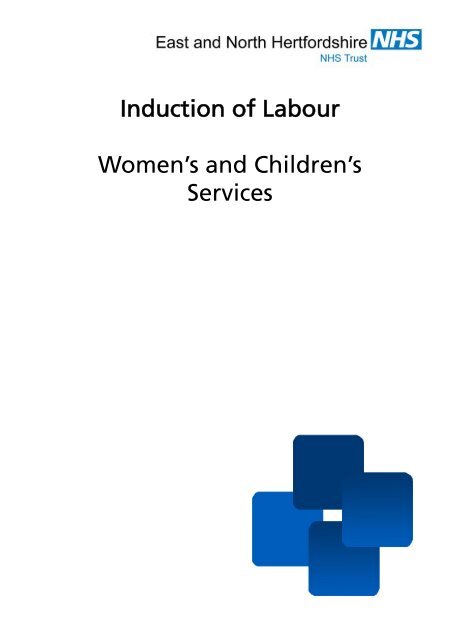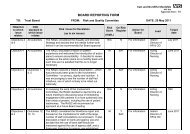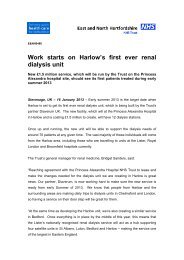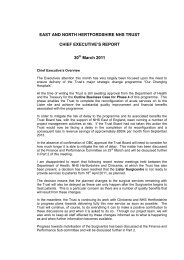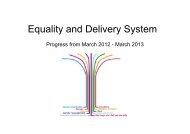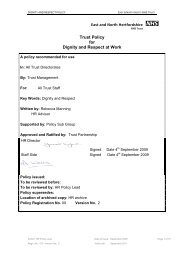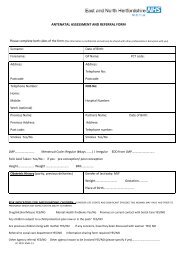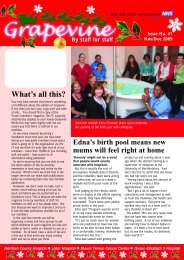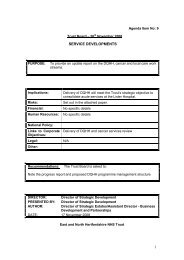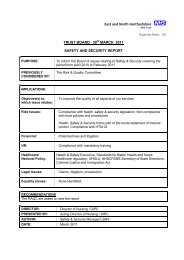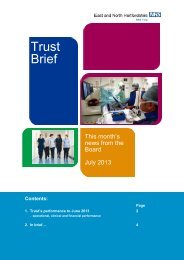Induction of Labour - East and North Herts NHS Trust
Induction of Labour - East and North Herts NHS Trust
Induction of Labour - East and North Herts NHS Trust
Create successful ePaper yourself
Turn your PDF publications into a flip-book with our unique Google optimized e-Paper software.
fåÇìÅíáçå=çÑ=i~Äçìê==<br />
=<br />
tçãÉåÛë=~åÇ=`ÜáäÇêÉåÛë==<br />
pÉêîáÅÉë=
2<br />
Blank<br />
=<br />
=<br />
=<br />
=<br />
=<br />
=<br />
=<br />
=<br />
=<br />
=<br />
=<br />
=<br />
=<br />
=<br />
=<br />
=<br />
=<br />
=<br />
=<br />
=<br />
=
3<br />
General Information<br />
This leaflet is for all pregnant women using Maternity services at<br />
<strong>East</strong> <strong>and</strong> <strong>North</strong> Hertfordshire <strong>NHS</strong> <strong>Trust</strong>, <strong>and</strong> is designed to give<br />
information about induction <strong>of</strong> labour to help you underst<strong>and</strong> the risks<br />
<strong>and</strong> benefits <strong>of</strong> induction for you <strong>and</strong> your baby.<br />
What is induction <strong>of</strong> labour?<br />
<strong>Induction</strong> <strong>of</strong> labour is a process designed to start your labour<br />
artificially.<br />
Why am I being <strong>of</strong>fered induction <strong>of</strong> labour?<br />
<strong>Induction</strong> <strong>of</strong> labour is <strong>of</strong>fered for a variety <strong>of</strong> reasons where it is felt<br />
that giving birth sooner would benefit the health <strong>of</strong> you or your baby.<br />
This may be because <strong>of</strong> medical conditions, for example diabetes or<br />
pre-eclampsia, or concerns about the baby’s growth or development.<br />
If this is the case, your doctor or midwife will discuss this with you<br />
fully.<br />
In most pregnancies labour will start spontaneously between 37 <strong>and</strong><br />
42 weeks but some normal healthy pregnancies continue<br />
beyond this time. After 41 weeks there is a slight increase in the risk<br />
<strong>of</strong> your baby developing health problems. After 42 weeks, more<br />
severe complications may be more likely. <strong>Induction</strong> <strong>of</strong> labour is<br />
therefore recommended between 41 <strong>and</strong> 42 weeks. Being induced<br />
because you are overdue does not increase the chance <strong>of</strong> you<br />
needing a Caesarean section.<br />
=<br />
In a normal, healthy pregnancy where you are well <strong>and</strong> your baby is<br />
well grown, there is evidence to show that there is no benefit to<br />
induce before 41 weeks. Although you may be feeling impatient <strong>and</strong><br />
uncomfortable at this time, there is still a strong chance <strong>of</strong> going into<br />
labour <strong>and</strong> giving birth naturally.
4<br />
Statistically at 41 weeks<br />
Six out <strong>of</strong> ten women will have their baby in the next three days<br />
Nine out <strong>of</strong> ten women will have their baby in the next seven<br />
days<br />
At the Lister <strong>and</strong> QEII hospitals you are unlikely to be <strong>of</strong>fered<br />
induction <strong>of</strong> labour until you are 10 – 12 days overdue (based on your<br />
dating scan), unless there is a clear medical indication to induce before<br />
this.<br />
What are the benefits <strong>and</strong> disadvantages <strong>of</strong> induction?<br />
Benefits<br />
Allows for early birth when mother’s or baby’s health is at risk.<br />
Babies born after 42 weeks <strong>of</strong> pregnancy are slightly more likely<br />
to have a difficult birth <strong>and</strong> a low Apgar score (a measure <strong>of</strong> well<br />
being at birth).<br />
Babies born after 42 weeks are more likely to open their bowels<br />
(pass meconium) during labour. This rarely causes a problem,<br />
but it can cause breathing problems if your baby inhales<br />
meconium.<br />
Disadvantages<br />
It may take longer for you to go into established labour.<br />
You may need more than one intervention to start or continue<br />
your labour.
5<br />
The induction may not work, which may result in further<br />
intervention, or a Caesarean section if you fail to go into labour.<br />
Your baby will need to be monitored more closely during labour.<br />
You are more likely to need assistance with your birth, e.g.<br />
ventouse (suction cap) or forceps.<br />
Is there any way to stimulate labour naturally?<br />
You may be able to help labour start naturally<br />
Raspberry leaf tea (made from fresh leaves or a sachet <strong>of</strong> dried<br />
leaf) or tablets taken after 36 weeks <strong>of</strong> pregnancy is said to tone<br />
the uterus. (There is no clear evidence that this helps but it does<br />
no harm.)<br />
Women have found other ways to stimulate labour, but these have not<br />
been fully researched for their safety or effectiveness. They include:<br />
Gentle nipple stimulation from 39 weeks is thought to encourage<br />
the release <strong>of</strong> natural oxytocin, which helps the uterus to<br />
contract, but you may not find it comfortable.<br />
Sexual intercourse – semen contains prostagl<strong>and</strong>in hormones<br />
that can help prepare your cervix for labour. However you<br />
should avoid full penetration if you have been told that you have<br />
a low placenta.<br />
Clitoral stimulation (female masturbation) could encourage<br />
uterine contractions.<br />
Gentle walking – gravity pushes your baby’s head down onto the<br />
cervix, <strong>and</strong> may help things along.
6<br />
A number <strong>of</strong> complementary therapies such as acupuncture or reflexology<br />
could be used. If you are interested in these you should seek advice<br />
from a fully qualified therapist, as some treatments may not be<br />
safe during pregnancy.<br />
If I choose to be induced, how will this happen?<br />
There are different methods for inducing labour outlined below. You<br />
may need only one, or all <strong>of</strong> these.<br />
Membrane sweeping<br />
The National Institute <strong>of</strong> Clinical Excellence (NICE) recommends that<br />
you should be <strong>of</strong>fered induction from 41 weeks. If you agree to this, the<br />
first stage is that your community midwife will <strong>of</strong>fer you a membrane<br />
sweep at 41 weeks. (There is no evidence to support membrane<br />
sweeping before 41 weeks).<br />
This involves the midwife doing an internal vaginal examination <strong>and</strong><br />
placing a finger inside the cervix <strong>and</strong> making circular movements to<br />
separate the membranes from the cervix. Membrane sweeping can be<br />
uncomfortable, <strong>and</strong> you may lose a small amount <strong>of</strong> blood afterwards<br />
but it will not harm the baby, or increase the risk <strong>of</strong> infection.<br />
This has been shown to increase the chance <strong>of</strong> labour starting within<br />
the next 48 hours <strong>and</strong> reduces the need for other methods <strong>of</strong> induction<br />
<strong>of</strong> labour. Membrane sweeps may be done either at clinic or at home<br />
<strong>and</strong> can be repeated after a few days, as this may help you to go into<br />
labour naturally.
7<br />
What happens next<br />
Following your sweep, if you choose to continue with an induction<br />
process, your midwife will arrange a date for you to be admitted to the<br />
hospital for further induction methods. This is usually between 10 <strong>and</strong><br />
12 days past your due date.<br />
If your pregnancy has been uncomplicated your induction will be<br />
started on the antenatal ward. If your pregnancy is high risk, for<br />
example you have had a previous Caesarean section operation, or<br />
your baby has not grown well, your induction will be started on the<br />
delivery suite. You will usually stay in hospital until after the birth, so<br />
you should bring your full hospital bag with you.<br />
Although we aim to start your induction promptly, there may be a<br />
delay at any stage <strong>of</strong> the induction if the maternity unit is unusually<br />
busy. While you are on the antenatal ward waiting for your labour to<br />
start, normal visiting hours will apply. When you are in labour <strong>and</strong><br />
moved to the delivery suite, your birth partner can stay with you all the<br />
time if you want.<br />
Before the induction can begin your baby will be given a heart tracing<br />
(CTG) for about 30 minutes to check that your baby is healthy.<br />
The midwife looking after you will suggest an internal examination to<br />
assess which method <strong>of</strong> induction is most appropriate for you.<br />
Prostagl<strong>and</strong>ins<br />
This is the most common method <strong>of</strong> induction. Prostagl<strong>and</strong>ins are<br />
drugs that stimulate the cervix to s<strong>of</strong>ten <strong>and</strong> begin to open, allowing<br />
contractions to start. The tablet is inserted behind the cervix during a<br />
vaginal examination. More than one dose may be needed to induce<br />
labour, <strong>and</strong> labour may still take several days to start.<br />
After the prostagl<strong>and</strong>in has been given, you will be asked to remain on<br />
the bed for 30 minutes so that your baby’s heartbeat can be<br />
monitored. After this, you can get up <strong>and</strong> walk around if you want to.
8<br />
When you are having regular contractions you will be <strong>of</strong>fered a further<br />
heart tracing which, if satisfactory, can be discontinued to allow you to<br />
mobilise.<br />
Advantages<br />
Can stimulate labour<br />
There is no evidence to suggest that labour induced by<br />
prostagl<strong>and</strong>in is more painful than spontaneous labour<br />
=<br />
Disadvantages<br />
Very occasionally the prostagl<strong>and</strong>in can cause the uterus to contract<br />
too much, which can affect your baby’s heartbeat, so this<br />
will be monitored closely<br />
The vaginal examination can be uncomfortable, <strong>and</strong> the<br />
prostagl<strong>and</strong>in can cause some vaginal soreness<br />
Some women may experience some period type pain, severe<br />
pain, backache, or regular contractions soon after prostagl<strong>and</strong>ins.<br />
This can subside after a time, or may develop into labour.<br />
Pain relief is available if you need it, just ask the midwife looking after<br />
you.
9<br />
Artificial rupture <strong>of</strong> the membranes (‘breaking your waters’)<br />
If you do not go into active labour following the prostagl<strong>and</strong>in, but your<br />
cervix has begun to open, your membranes can be ruptured during a<br />
vaginal examination. This will then be followed as soon as possible<br />
by administering syntocinon, which is performed on the delivery suite .<br />
Disadvantages<br />
The procedure may be slightly uncomfortable, <strong>and</strong> may cause<br />
your contractions to increase in strength<br />
It is more likely that you will require stronger methods <strong>of</strong> pain<br />
relief<br />
Your amniotic fluid will continue to leak, so you will be given<br />
sanitary towels to wear<br />
After it is done, you will be given a couple <strong>of</strong> hours to walk around to<br />
see if labour starts by itself.<br />
Syntocinon<br />
Syntocinon is a drug that encourages contractions. It is given directly<br />
into your bloodstream through a cannula (tiny tube) into a vein in the<br />
h<strong>and</strong> or arm. It can only be given on the delivery suite. When<br />
contractions have started, the drip can be adjusted to keep your<br />
contractions regular until after the birth.<br />
Disadvantages<br />
Very occasionally, syntocinon can cause the uterus to contract<br />
too much, which can cause the pattern <strong>of</strong> your baby’s heart beat<br />
to change. It is recommended that your baby’s heart beat be<br />
monitored continuously throughout your labour
10<br />
Syntocinon should not usually be started until at least six hours<br />
after your last prostagl<strong>and</strong>in<br />
Contractions may become strong <strong>and</strong> painful more quickly<br />
You are more likely to require an epidural for pain relief<br />
You will be less able to remain very mobile<br />
Syntocinon is usually the final option for induction, so if this does not<br />
lead to the birth <strong>of</strong> your baby, you may need a Caesarean section.<br />
What if I choose not to be induced?<br />
Your doctor or midwife may <strong>of</strong>fer induction <strong>of</strong> labour, but it remains<br />
your choice whether to go ahead with it or not. If you choose not to be<br />
induced, it is important to check that you <strong>and</strong> your baby remain<br />
healthy.<br />
You will be asked to let the midwife or hospital know if your<br />
baby’s movements become less frequent or change<br />
significantly.<br />
You may be <strong>of</strong>fered an ultrasound scan to check that there is<br />
enough fluid around the baby, <strong>and</strong> that it is a good size <strong>and</strong><br />
there is good blood supply from the placenta (Doppler). This will<br />
be discussed with your obstetrician.<br />
You will be <strong>of</strong>fered twice weekly heart tracings (CTG). If you<br />
prefer to be monitored more frequently (even daily) this can be<br />
arranged. CTGs take approximately 30-60 minutes <strong>and</strong> check<br />
that the baby is healthy, but CTGs cannot predict how well the<br />
baby will cope once labour starts.
11<br />
Blank
=<br />
Further information<br />
Our hospital policy is based on the recommendations <strong>of</strong> the National<br />
Institute for Clinical Excellence (NICE). For more information you can<br />
visit their website at www.nice.org.uk<br />
We have produced a separate leaflet ‘What to do if your waters have<br />
broken?’<br />
MIDIRS informed choice leaflet ‘When your baby is overdue’<br />
www.infochoice.org<br />
www.nhsdirect.nhs.uk<br />
Contact details<br />
Should you need further information to help you to decide if induction<br />
is right for you, talk to your community midwife or doctor, or contact<br />
the hospital.<br />
Lister Antenatal Clinic 01438 314333 ext. 4070<br />
QEII Antenatal Clinic 01707 328111 ext.4600<br />
<strong>NHS</strong> Direct Tel 08 45 46 47<br />
=<br />
=<br />
vçì=~åÇ=óçìê=Ä~Äó=~êÉ=áãéçêí~åí=íç=ìë=Ó=<br />
qÜ~åâ=óçì=Ñçê=ÅÜççëáåÖ=b~ëí=~åÇ=kçêíÜ=eÉêíë=kep=qêìëí=<br />
a~íÉ=çÑ=éìÄäáÅ~íáçåW=aÉÅÉãÄÉê=OMNM=<br />
^ìíÜçêW=pìÉ=kçêêáë==EOMMSF=====<br />
oÉîáÉïÉÇ=Äó=h=dä~ÇïÉää=E^ìÖ=OMNMF=<br />
oÉÑÉêÉåÅÉW==fli= = = sÉêëáçåW=NKN=<br />
oÉîáÉï=a~íÉW=aÉÅÉãÄÉê=OMNO=<br />
«=b~ëí=~åÇ=kçêíÜ=eÉêíÑçêÇëÜáêÉ=kep=qêìëí=<br />
=<br />
ïïïKÉåÜÉêíëJíêKåÜëKìâ=<br />
vçì=Å~å=êÉèìÉëí=íÜáë==========<br />
áåÑçêã~íáçå=áå=~=====<br />
ÇáÑÑÉêÉåí=Ñçêã~í=çê=<br />
~åçíÜÉê=ä~åÖì~ÖÉK=


